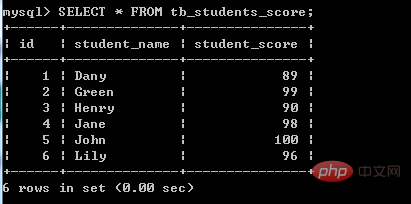How to query the maximum id value in mysql
In mysql, you can use the SELECT statement to query all the data in the specified table, and then use the max() function to return the maximum value of the id column in the query result set. The query syntax "SELECT MAX(id) FROM table name;". The max() function is used to return the maximum value in the specified column in the query result set, the syntax is "MAX (column name)"; and if you want to obtain the maximum value of the id column, the parameter value in the max() function needs to be set to id.

The operating environment of this tutorial: windows7 system, mysql8 version, Dell G3 computer.
In mysql, you can use the SELECT statement with the max() function to query the maximum id value.
First use the SELECT statement to query all the data in the specified table
Then use the max() function to return the id column in the query result set The maximum value is
SELECT MAX(列名) FROM 表名;
MAX() function is used to return the maximum value in the specified column. The accepted parameter is the specified column name; therefore, if you want to query the maximum id value, just Get the maximum value of the id column.
So the complete syntax for querying the maximum id value is:
SELECT MAX(id) FROM 表名;
Example:
Create a tb_students_score table, insert the data, and query all data
SELECT * FROM tb_students_score;

Query the maximum id value:
SELECT MAX(id) FROM tb_students_score;

Extended knowledge:
MAX() function returns the maximum value in a set of values. The MAX() function is very convenient in many queries, such as finding the maximum quantity, the most expensive product, and the maximum payment by a customer.
The syntax of the MAX() function is as follows:
MAX(DISTINCT expression);
If you add the DISTINCT operator, the MAX() function returns the maximum value of different values, which is the same as that of all values The maximum values are the same. This means that the DISTINCT operator will not have any impact on the MAX() function (it can be used with or without the DISTINCT operator).
Please note that the DISTINCT operator takes effect in other aggregate functions such as COUNT, SUM and AVG.
MySQL MAX function in subquery
Not only to get the maximum payment amount, but also to get other payment information, such as customer number, For check number and payment date, you can use the MAX function in a subquery, as shown below:
SELECT
*
FROM
payments
WHERE
amount = (
SELECT
MAX(amount)
FROM
payments);Execute the above query statement and get the following results
+----------------+-------------+-------------+-----------+ | customerNumber | checkNumber | paymentDate | amount | +----------------+-------------+-------------+-----------+ | 141 | JE105477 | 2015-03-18 | 120166.58 | +----------------+-------------+-------------+-----------+ 1 row in set
How does the above query statement run? The subquery returns all maximum payment amounts. The outer query retrieves other related payment information for an amount equal to the maximum amount returned from the subquery. Another method without using the MAX function is to use the ORDER BY clause to sort the result set in descending order, and use the LIMIT clause to get the first row, as in the following query:
SELECT
*
FROM
payments
ORDER BY amount DESC
LIMIT 1;Execute the above query statement and get the following Result
+----------------+-------------+-------------+-----------+ | customerNumber | checkNumber | paymentDate | amount | +----------------+-------------+-------------+-----------+ | 141 | JE105477 | 2015-03-18 | 120166.58 | +----------------+-------------+-------------+-----------+ 1 row in set
If you do not create an index on the amount column, the second query executes faster because it checks all rows in the payments table, while the first query checks all rows in the payments table All rows twice, once in the subquery and once in the outer query. However, if the amount column is indexed, the first query will execute faster.
[Related recommendations: mysql video tutorial]
The above is the detailed content of How to query the maximum id value in mysql. For more information, please follow other related articles on the PHP Chinese website!

Hot AI Tools

Undresser.AI Undress
AI-powered app for creating realistic nude photos

AI Clothes Remover
Online AI tool for removing clothes from photos.

Undress AI Tool
Undress images for free

Clothoff.io
AI clothes remover

AI Hentai Generator
Generate AI Hentai for free.

Hot Article

Hot Tools

Notepad++7.3.1
Easy-to-use and free code editor

SublimeText3 Chinese version
Chinese version, very easy to use

Zend Studio 13.0.1
Powerful PHP integrated development environment

Dreamweaver CS6
Visual web development tools

SublimeText3 Mac version
God-level code editing software (SublimeText3)

Hot Topics
 1374
1374
 52
52
 The relationship between mysql user and database
Apr 08, 2025 pm 07:15 PM
The relationship between mysql user and database
Apr 08, 2025 pm 07:15 PM
In MySQL database, the relationship between the user and the database is defined by permissions and tables. The user has a username and password to access the database. Permissions are granted through the GRANT command, while the table is created by the CREATE TABLE command. To establish a relationship between a user and a database, you need to create a database, create a user, and then grant permissions.
 RDS MySQL integration with Redshift zero ETL
Apr 08, 2025 pm 07:06 PM
RDS MySQL integration with Redshift zero ETL
Apr 08, 2025 pm 07:06 PM
Data Integration Simplification: AmazonRDSMySQL and Redshift's zero ETL integration Efficient data integration is at the heart of a data-driven organization. Traditional ETL (extract, convert, load) processes are complex and time-consuming, especially when integrating databases (such as AmazonRDSMySQL) with data warehouses (such as Redshift). However, AWS provides zero ETL integration solutions that have completely changed this situation, providing a simplified, near-real-time solution for data migration from RDSMySQL to Redshift. This article will dive into RDSMySQL zero ETL integration with Redshift, explaining how it works and the advantages it brings to data engineers and developers.
 Do mysql need to pay
Apr 08, 2025 pm 05:36 PM
Do mysql need to pay
Apr 08, 2025 pm 05:36 PM
MySQL has a free community version and a paid enterprise version. The community version can be used and modified for free, but the support is limited and is suitable for applications with low stability requirements and strong technical capabilities. The Enterprise Edition provides comprehensive commercial support for applications that require a stable, reliable, high-performance database and willing to pay for support. Factors considered when choosing a version include application criticality, budgeting, and technical skills. There is no perfect option, only the most suitable option, and you need to choose carefully according to the specific situation.
 Query optimization in MySQL is essential for improving database performance, especially when dealing with large data sets
Apr 08, 2025 pm 07:12 PM
Query optimization in MySQL is essential for improving database performance, especially when dealing with large data sets
Apr 08, 2025 pm 07:12 PM
1. Use the correct index to speed up data retrieval by reducing the amount of data scanned select*frommployeeswherelast_name='smith'; if you look up a column of a table multiple times, create an index for that column. If you or your app needs data from multiple columns according to the criteria, create a composite index 2. Avoid select * only those required columns, if you select all unwanted columns, this will only consume more server memory and cause the server to slow down at high load or frequency times For example, your table contains columns such as created_at and updated_at and timestamps, and then avoid selecting * because they do not require inefficient query se
 How to optimize MySQL performance for high-load applications?
Apr 08, 2025 pm 06:03 PM
How to optimize MySQL performance for high-load applications?
Apr 08, 2025 pm 06:03 PM
MySQL database performance optimization guide In resource-intensive applications, MySQL database plays a crucial role and is responsible for managing massive transactions. However, as the scale of application expands, database performance bottlenecks often become a constraint. This article will explore a series of effective MySQL performance optimization strategies to ensure that your application remains efficient and responsive under high loads. We will combine actual cases to explain in-depth key technologies such as indexing, query optimization, database design and caching. 1. Database architecture design and optimized database architecture is the cornerstone of MySQL performance optimization. Here are some core principles: Selecting the right data type and selecting the smallest data type that meets the needs can not only save storage space, but also improve data processing speed.
 How to fill in mysql username and password
Apr 08, 2025 pm 07:09 PM
How to fill in mysql username and password
Apr 08, 2025 pm 07:09 PM
To fill in the MySQL username and password: 1. Determine the username and password; 2. Connect to the database; 3. Use the username and password to execute queries and commands.
 Understand ACID properties: The pillars of a reliable database
Apr 08, 2025 pm 06:33 PM
Understand ACID properties: The pillars of a reliable database
Apr 08, 2025 pm 06:33 PM
Detailed explanation of database ACID attributes ACID attributes are a set of rules to ensure the reliability and consistency of database transactions. They define how database systems handle transactions, and ensure data integrity and accuracy even in case of system crashes, power interruptions, or multiple users concurrent access. ACID Attribute Overview Atomicity: A transaction is regarded as an indivisible unit. Any part fails, the entire transaction is rolled back, and the database does not retain any changes. For example, if a bank transfer is deducted from one account but not increased to another, the entire operation is revoked. begintransaction; updateaccountssetbalance=balance-100wh
 MySQL: The Ease of Data Management for Beginners
Apr 09, 2025 am 12:07 AM
MySQL: The Ease of Data Management for Beginners
Apr 09, 2025 am 12:07 AM
MySQL is suitable for beginners because it is simple to install, powerful and easy to manage data. 1. Simple installation and configuration, suitable for a variety of operating systems. 2. Support basic operations such as creating databases and tables, inserting, querying, updating and deleting data. 3. Provide advanced functions such as JOIN operations and subqueries. 4. Performance can be improved through indexing, query optimization and table partitioning. 5. Support backup, recovery and security measures to ensure data security and consistency.




